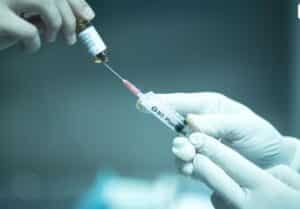Orthopedic Injections – What Are We Putting Into You?

When it comes to treating a patient, surgery is typically one of the last options your doctor will turn to. To deter the need for joint replacement surgery, your doctor might recommend the use of orthopedic injections. But what are orthopedic injections and how can they help you? Orthopedic injections can help eliminate pain caused by inflammation and can aid you in the healing process.
If your doctor is recommending orthopedic injections, you may be curious about what they specifically can do within your body and how exactly they can benefit you. You also might be wondering about the different types of injection therapies, and which is right for you. Let’s take a look at the different types of injections and each of their potential benefits, risks, the conditions they are best suited to help, and what recovery looks like for each one.
There are two main types of orthopedic injections that you may have heard of: steroid injection therapy and non-steroid injection therapy, such as hyaluronic acid treatment. We’re going to dive into each of these types of orthopedic injections to discuss their benefits, risks and how they work, starting with steroid injection therapy.
Steroid injections
Steroid injection therapy uses corticosteroids, which are injected into the body into a problem area to provide immediate pain relief and anti-inflammation. “Corticosteroids suppress the multiple inflammatory genes that are activated in chronic inflammatory diseases,” according to this study, and they accomplish this by mimicking the body’s natural hormones such as cortisol. Cortisol is a hormone created in the body that can boost your immunity by limiting inflammation.
Steroid injections are used for many ailments and to several different intensities, however, they are most commonly used:
- To help inflamed tendons (tendonitis) near the shoulder, elbow, hip, knee, hand, or wrist
- For Rheumatoid arthritis
- For Gout
- Or for Inflamed bursae (bursitis)
Steroid injection therapy is a fairly simple process. Corticosteroids are directly injected into the joint or muscle which is experiencing the pain. This steroid helps reduce the swelling, inflammation, and pain that is caused by swelling and inflammation. Injections are a distinctly effective route in pain management since they deliver a high dose of medication directly to a problem spot in the body. Unlike other forms of medication, steroids do not have to travel throughout the body to get the job done. Steroid injection is a great approach to target pain directly, specifically if the pain has become constant or has turned into a repetitive issue for the patient.
The risks of steroid injection therapy depend on the frequency of injections into the body. If a patient needs larger doses and repeated use of corticosteroids, risks, and side effects are more likely. Because of this, shots into the joint are typically limited by the doctor. Here are some risks that can occur, notably if injections are too frequent or too close together:
- Cartilage damage
- Death/injury of nearby bone
- Joint infection
- Nerve damage
- Temporary facial flushing
- A temporary flare of pain/inflammation in the affected area
- Temporary increase in blood sugar
- Tendon weakening or rupturing
- Thinning of nearby bone (otherwise known as osteoporosis)
- Thinning of the skin and the soft tissue around the injection site
- Lightening of the skin around the injection site
Even beyond potential risks, steroid injections are typically an effective and successful form of pain management. The effects of steroid injections can last for months and help rid patients of inflammation and pain.
To recover from a steroid injection, doctors will recommend that you protect the injection area for several days, avoid heavy lifting, stay off your feet if the injection is near the lower leg, apply ice to the injection location, avoid hot water for several days, and keep an eye out for signs of infection. Your doctor may have further instructions based on your body and your procedure.
Non-Steroid injection therapy
Non-steroid injection therapy, much like steroid injection therapy is directly injected into a problem area. There are many forms of non-steroid injection therapy, but one of the most popular forms is hyaluronic acid treatment, such as Hymovis®. Instead of imitating the body’s natural hormones, hyaluronic acid treatment is used to imitate the body’s natural hyaluronic acid to lubricate your joints. Certain conditions, like osteoarthritis for example, can cause your body to lose its natural hyaluronic acid. Your body’s natural hyaluronic acid provides your joints with lubrication, so without it, you might be experiencing pain. Hyaluronic acid treatment attempts to recreate a healthy joint, making it easier for your body to move again, without the pain and inflammation caused by your condition.
Non-steroid injection therapy often is used to treat:
- Osteoarthritis, specifically for patients who have failed to respond to other forms of treatment, such as non-pharmacologic therapy or simple analgesics
- Patients with knee osteoarthritis
Non-steroid injection therapy is administered in the same way as steroid injection therapy. Hyaluronic treatments are directly injected into the joint or muscle which is experiencing the pain. Much like steroid injections, an ultrasound can be used to ensure the needle is placed in the correct spot, where the injury within the body resides.
Non-steroid injection therapy comes with several of the same risks as steroid injection therapy. Patients should expect a flare of inflammation and pain in the surrounding area at the injection site shortly after the injection. However, once this goes down, hyaluronic acid injections can improve body mobility, reduce swelling and pain, and can defer the necessity of joint replacement surgery.
Hymovis® and hyaluronic acid treatments should not be used on:
- Patients with previous reactions such as hypersensitivity (allergy) to hyaluronate preparations
- Patients who have infections or skin diseases in the area of the injection site or joint
- Or pregnant women, nursing mothers, or children
Recovering from a non-steroid injection is similar to the process of recovering from a steroid injection. Your doctor may recommend that you protect the injection area for several days, avoid heavy lifting, stay off your feet if the injection is near the lower leg, apply ice to the injection location, avoid hot water for several days, and keep an eye out for signs of infection. However, listen to your doctor’s specific instructions since every case is different.
When might you need orthopedic injection therapy?
It is extremely important to consult with a qualified healthcare professional before undergoing orthopedic injections. Making informed decisions about your treatment options should always be the goal, so make sure to ask your doctor any questions you have before you proceed with treatment.
Your doctor may recommend orthopedic injections as a next step if medication or previous treatments have not worked for you. This may be the use of anti-inflammatory drugs, non-pharmacologic therapy, or simple analgesics. Before your doctor begins to turn to joint replacement surgery, orthopedic injections can be a conservative step to providing you with comfort.
Always talk with your orthopedic doctor if you are experiencing joint pain. Your doctor will be able to help you form an action plan, catered to your unique problems and treatment goals.
